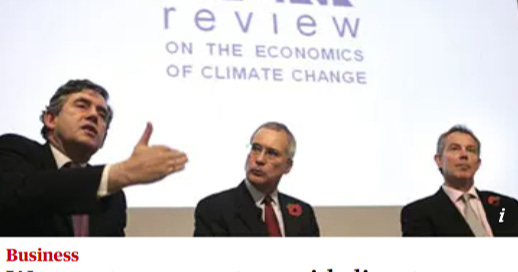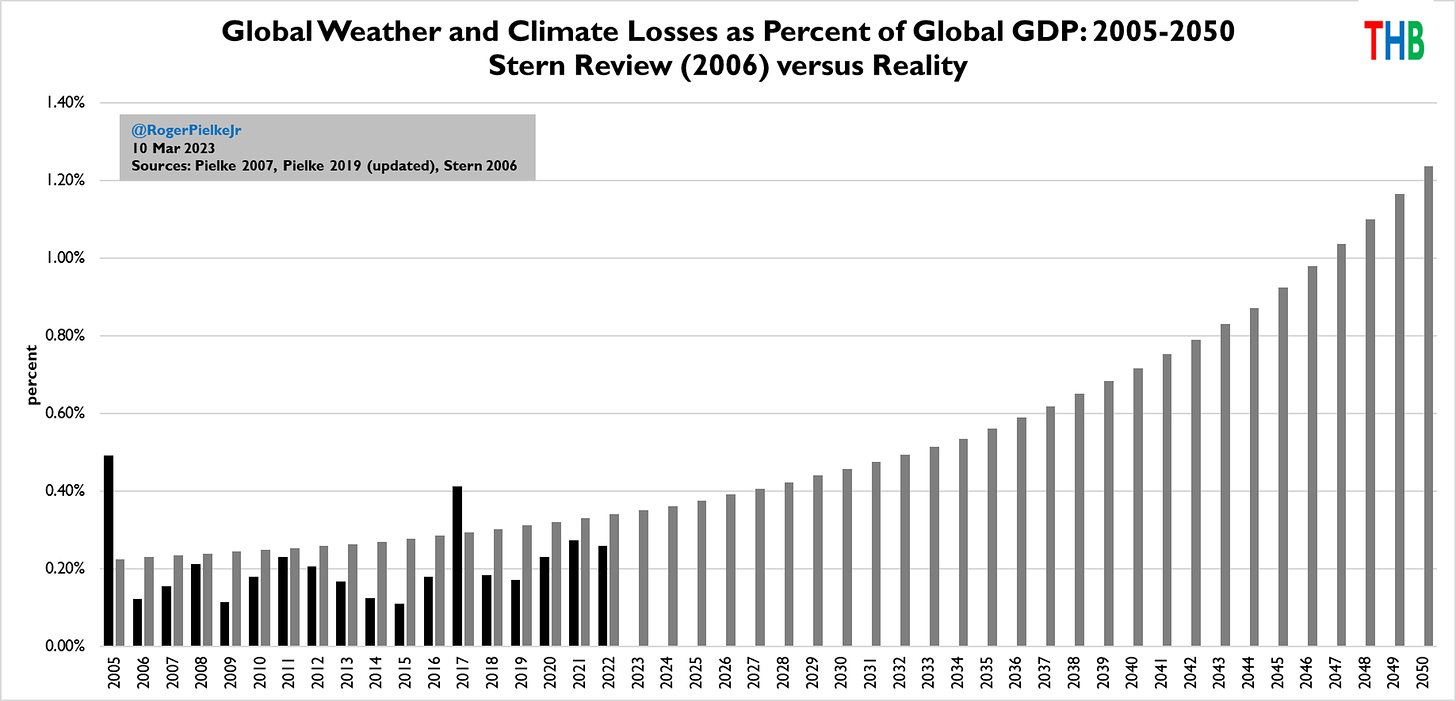Off Target: An Evaluation of the Stern Review's Climate Disaster Predictions
Escalating climate destruction has yet to occur as forecast
It seems like ancient history today, but the 2006 report on climate change by Nicholas Stern, produced at the request of the British Government had a significant impact on discussions of climate policy. The “Stern Review” as it was called focused on the economics of climate change and climate policy.
Among the report’s conclusions was a prediction of how climate and weather related disasters would increase in coming years and decades. Now, 17 years later, we can take a look at how well that prediction has fared.
In short, not so well.
The report acknowledged correctly that weather and climate disasters over the decades leading to 2005 totaled about 0.2% of global GDP every year, on average. It then projected that such losses would increase by almost an order or magnitude or more by 2050 and continue to increase through the 21st century.
The report explained its methodology as follows:
Based on simple extrapolation through to the 2050s. The lower bound assumes a constant 2% increase in costs of extreme weather over and above changes in wealth and inflation. The upper band assumes that the rate of increase will increase by 1% each decade, starting at 2% today, 3% in 2015, 4% in 2025, 5% in 2035, and 6% in 2045. These values are likely underestimates: (1) they exclude “small-scale” events which have large aggregate costs, (2) they exclude data for some regions (Africa and South America), (3) they fail to capture many of the indirect economic costs, such as the impacts on oil prices arising from damages to energy infrastructure, and (4) they do not adjust for the reductions in losses that would have otherwise occurred without disaster mitigation efforts that have reduced vulnerability.
The accelerating rate of increase in the “upper bound” does not make a material difference in an evaluation through 2022. (The basis for this prediction has an interesting back story.)
Let’s take a look at how the Stern prediction compares with the actual evolution of weather and climate disasters from 2005 to 2022, which is shown in the figure below.
The figure shows (in grey) the Stern Review’s projected increase in the impacts of weather and climate disasters as a proportion of global GDP — increasing from about 0.2% of global GDP to about 0.35%. The black bars show the actual data, based on the frequent updates I provide here to my peer-reviewed 2019 paper. The dashed lines show the linear trends over the period.
In the 16 years since 2005, global disaster losses as a proportion of GDP have only exceeded those predicted in the Stern Review in 1 year (2017). To put this in dollar terms, in 2022 dollars the Stern Review’s projection cumulatively was about $1 trillion dollars too high, as compared with what actually happened. The Stern Review’s failed prediction is good news for the world.
Finally, the figure below shows the Stern Review upper bound prediction to 2050, which it claimed was “likely” an underestimate.
In 2022 dollar terms, the Stern Review’s projection for 2050 equates to more than $1.2 trillion in losses in that year. So far, the Stern Review has over-estimated how weather and climate damages would evolve. Looking to the future, I’ll continue to take the under.
I don’t get everything right, far from it. But I did get this one right. For paid subscribers below, a PDF of my 2007 paper that critiqued the Stern Review’s treatment of disasters:
Pielke Jr, R. (2007). Mistreatment of the economic impacts of extreme events in the Stern Review Report on the Economics of Climate Change. Global Environmental Change, 17(3-4), 302-310.
The Stern Review on the Economics of Climate Change has focused debate on the costs and benefits of alternative courses of action on climate change. This refocusing has helped to move debate away from science of the climate system and on to issues of policy. However, a careful examination of the Stern Review's treatment of the economics of extreme events in developed countries, such as floods and tropical cyclones, shows that the report is selective in its presentation of relevant impact studies and repeats a common error in impacts studies by confusing sensitivity analyses with projections of future impacts. The Stern Review's treatment of extreme events is misleading because it overestimates the future costs of extreme weather events in developed countries by an order of magnitude. Because the Stern Report extends these findings globally, the overestimate propagates through the report's estimate of future global losses. When extreme events are viewed more comprehensively the resulting perspective can be used to expand the scope of choice available to decision makers seeking to grapple with future disasters in the context of climate change. In particular, a more comprehensive analysis underscores the importance of adaptation in any comprehensive portfolio of responses to climate change.






